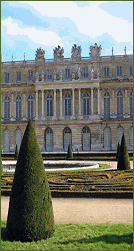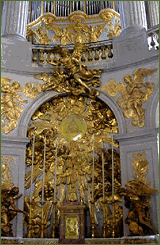|
Chateau de Versailles has played major roles throughout its
existence, not only during the French monarchy, but throughout the history of the French
Republic and this palace is still used for both houses of parliament to sit.
Situated several kilometres Southwest of Paris,
Chateau de Versailles was originally no more than a modest hunting lodge that was built by
King Louis XIII in 1623. But his son, King Louis XIV abandoned the Louvre wishing to build a royal palace in place
of this lodge and because he was so taken with the palace, in 1682 it become the official
residence of the Sun King and his Court, replacing the Louvre and Saint-Germain Castles,
which gave a grand statement of monarchical power. He also insisted that the Chateau
de Versailles was for the people, and that his home should be open to one and all who
wanted to visit.
The architect Jules Hardouin Mansart transformed the modest hunting lodge and Andre Le
Notre designed the gardens between 1661 and 1700. One of the last parts to be built
under Jules Hardouin Mansart and Robert de Cotte was The Chapel in 1710 and is one of the
architectural highlights of this famous palace Versailles.
But Andre Le Notre who also designed the gardens at Fontainbleau Chateau, designed the garden
to include numerous fountains, jets, waterfalls, a vast amount of sculptures and statues,
water parterres, and formal gardens, which has turned this into the most famous garden in
the world, although with its size and grandeur, you cannot really call it a garden!
Chateau de Versailles also has later additions such as the Petit Trianon, which was given
to Marie-Antoinette in 1774. The Hameau was designed in 1785, as a stage village for
Marie-Antoinette in which to play with her friends, as she favoured the irregular style,
with hills, rocks and streams.
The Chateau de Versailles castle has over 2,000 windows, 700 rooms, over 1,200 fireplaces,
67 staircases and also includes the 75m Galerie des Glaces, otherwise known as the Hall of
Mirrors, where the Treaty of Versailles was signed in 1919, signifying the end of World
War I.
In 1789, the royal family returned to Paris and then in 1837 King Louis-Philippe decided
to convert this magnificent palace into a museum of French History, which was to be
dedicated to 'all of France's glories' and hence there are only victories depicted and not
any defeats!
However, a vast amount of construction work had to be undertaken to transform many of the
areas into museum galleries, so that the
paintings could be hung, as apart from the older works dating from the Middle Ages up
until around 1830, King Louis-Philippe also commissioned around 3,000 paintings from all
of the major artists of the day so that there would be a complete museum of French history
depicted within the works.
The vast amount and the quality of depictions by famous artists through its paintings,
sculptures, tapestries and furniture makes the Chateau de Versailles an outstanding
portrait museum with the very best of Italian and French artists of the time being shown.
The interior visit, which you can enjoy with a speaking guide in French, Spanish or
English, or with your own set of headphones, will introduce you to the immense luxury and
magnificence of the Chateau, with its famous Hall of Mirrors as well as the lavishly
decorated King's Bedroom, plus the curators have been tirelessly concentrating on the
restoration of the original decor within state apartments, private apartments and
princesses' apartments since the early 20th century.
The museum founded by King Louis-Philippe can still be seen in the lateral wings, yet
there are also other galleries which are devoted to things such as the French Revolution,
the Crusades and the Battle gallery, which at 120 metres is the longest hall in the
Chateau and depicts France's great battles in a cycle of monumental paintings. Other
18th century collections are distributed throughout some of the restored apartments.
The Versailles gardens include around 1,300 fountains, which use water pumped from the River Seine and you can view a fountain show at a weekend from
April until September.
This chateau, full of wealth and luxury is definitely well worth visiting whilst on
holiday, although in the height of season you can often find there will be a long queue
just to get in, but once there you will not be disappointed.
The nearest airports to the Chateau de Versailles are the Charles de Gaulle Airport or
Paris Orly Airport, whereas if you are traveling by car then you will need to take the 1st
exit, which is sign posted Versailles-Chateau, when heading towards Rouen.
|
|



